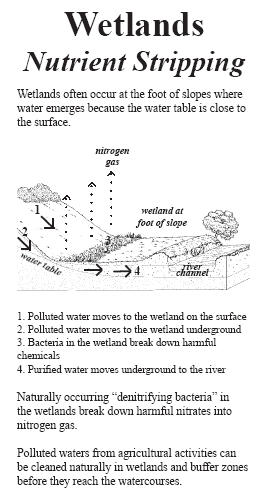wetlands
 |
Wetland area at
Coldrinnick |
‘Wetlands’ is a general
term used to describe habitats that are dominated by water. This
means that rivers, ponds, lakes, marshes and wet meadows can all
be referred to as wetlands.
Rivers and streams are an important
part of the water cycle (B02)
and the life they support, both plant and animal (which of course
includes human life) is explored throughout the various sections
in this pack. So let us concentrate on the importance of wetlands
as marshes and wet meadows.
 |
Wetland on Bodmin
Moor |
Marshes and wet meadows are places
where the water table (the level of water in the ground) is high
and therefore the water can be seen on the ground’s surface.
These wetland areas are important because of the species of plants
and animals that live in them and rely upon the wetland for food,
shelter and nesting. Mammals such as shrews and birds like cormorant
and heron might be found in wetland areas like these in Cornwall.
Wetlands are also important because
of the bacteria found in them that works to break down pollution
in the water before it reaches a pond, river or stream where it
can harm the plants and creatures living there. Willow trees and
reed mace are two examples of plants that thrive in wetland areas
and help in the process of breaking down harmful chemicals before
they reach a stream or river. This is why wetland areas like wet
meadows and marshes are sometimes described as buffer zones (L06f).
They process the water that is moving on and through the ground
to the river or stream.
Click on the image below to see
a diagram showing how a wetland works

|

